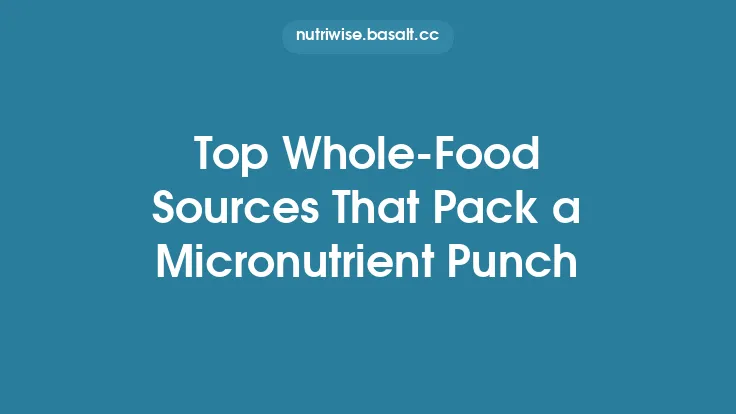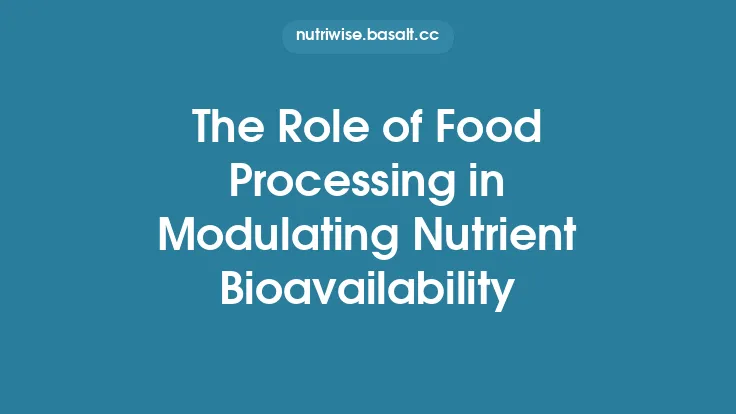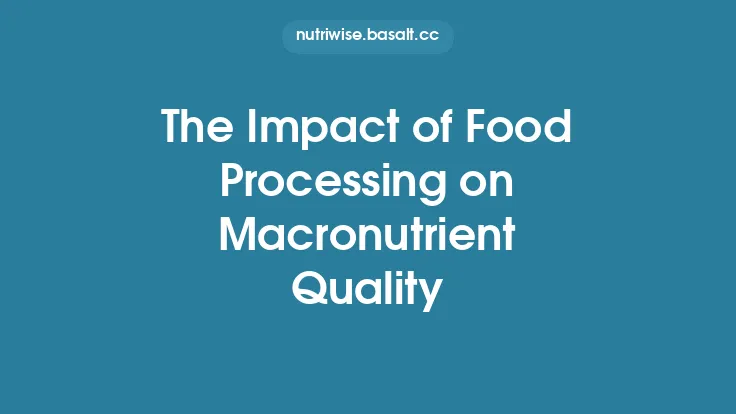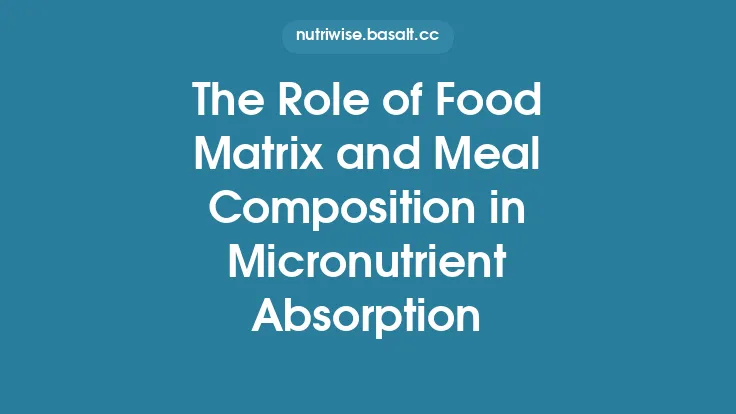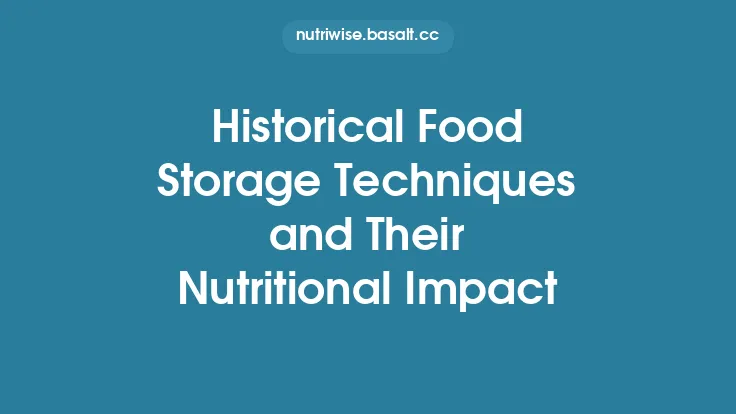Micronutrients—vitamins, minerals, and phytonutrients—are present in foods in minute quantities, yet they play outsized roles in human health. While the nutritional composition of raw agricultural produce is often impressive, the journey from farm to fork inevitably involves a series of processing steps that can jeopardize the delicate balance of these compounds. Unlike macronutrients, which are relatively robust, many micronutrients are highly sensitive to heat, oxygen, light, and mechanical stress. Consequently, the choice and optimization of processing techniques become pivotal in preserving not only the absolute content of micronutrients but also their bioavailability—the proportion that remains absorbable after digestion.
The following sections explore the spectrum of food‑processing technologies that have been demonstrated, through both laboratory and commercial studies, to safeguard micronutrient integrity. Emphasis is placed on mechanisms of protection, critical control points, and practical implications for manufacturers and informed consumers alike. The discussion deliberately steers clear of cooking‑method effects, dietary enhancers or inhibitors, gut‑health interactions, and timing strategies, focusing instead on the processing domain itself.
Understanding the Challenges of Micronutrient Retention During Processing
- Thermal Degradation
- Kinetic Sensitivity: Many vitamins (e.g., vitamin C, thiamine, folate) follow first‑order degradation kinetics with activation energies ranging from 30–80 kJ mol⁻¹. Even brief exposure to temperatures above 60 °C can halve their concentrations.
- Mineral Leaching: Water‑soluble minerals such as potassium and magnesium may diffuse out of plant tissues during blanching or boiling, reducing the final content.
- Oxidative Losses
- Lipid‑Soluble Vitamins: Vitamin A (retinol) and vitamin E (tocopherols) are prone to peroxidation when exposed to oxygen, especially in the presence of unsaturated fatty acids.
- Metal Catalysis: Transition metals (Fe²⁺, Cu⁺) can catalyze radical formation, accelerating oxidation of sensitive compounds.
- Photolysis
- Light, particularly UV‑B, can break down riboflavin, folate, and certain carotenoids. Transparent packaging or exposure during drying can be detrimental.
- Mechanical Shear and Enzymatic Activity
- High shear forces can rupture cell walls, releasing enzymes (e.g., polyphenol oxidase) that degrade phenolic micronutrients.
- Endogenous enzymes may remain active post‑harvest, catalyzing nutrient loss unless inactivated appropriately.
- Matrix Interactions
- Micronutrients bound to proteins, fibers, or phytates may become less extractable if processing disrupts these associations unfavorably.
Understanding these pathways informs the design of processing interventions that either mitigate the damaging factors or protect the micronutrients through physical or chemical means.
Gentle Thermal Techniques: Freeze‑Drying and Vacuum‑Drying
Freeze‑Drying (Lyophilization)
- Principle: Water is sublimated from frozen material under low pressure, bypassing the liquid phase.
- Micronutrient Preservation: The low temperature (< −40 °C) and absence of liquid water dramatically reduce thermal and oxidative degradation. Studies on freeze‑dried berries report retention of > 90 % of vitamin C and anthocyanins compared with fresh fruit.
- Bioavailability Considerations: The porous structure generated by sublimation enhances rehydration and subsequent release of micronutrients during digestion, often improving in‑vitro bioaccessibility.
Vacuum‑Drying (Low‑Temperature Dehydration)
- Principle: Drying under reduced pressure lowers the boiling point of water, allowing moisture removal at temperatures typically ≤ 60 °C.
- Advantages: Minimal heat exposure curtails thermal loss, while the vacuum environment limits oxygen, reducing oxidative reactions.
- Application Example: Vacuum‑dried spinach retains up to 80 % of its folate content, outperforming conventional hot‑air drying (≈ 45 % retention).
Both methods are energy‑intensive but are justified for high‑value, micronutrient‑dense products such as functional powders, instant soups, and nutraceutical ingredients.
High‑Pressure Processing (HPP): Preserving Structure and Nutrient Integrity
Mechanism
- HPP subjects foods to pressures of 300–600 MPa for seconds to minutes, uniformly transmitted through the product. The process inactivates microorganisms and many enzymes without raising temperature significantly (adiabatic heating < 5 °C).
Impact on Micronutrients
- Vitamins: Vitamin C loss in HPP‑treated fruit purees is typically < 10 % versus > 30 % in conventional pasteurization.
- Minerals: Since HPP does not involve water exchange, mineral leaching is negligible.
- Phytonutrients: Carotenoids and flavonoids often show improved extractability post‑HPP due to cell‑wall disruption, which can enhance bioavailability.
Operational Considerations
- Packaging: Foods must be sealed in flexible, high‑barrier pouches to transmit pressure.
- Product Suitability: HPP is ideal for liquid foods (juices, smoothies), soft solids (pâtés), and ready‑to‑eat meals where heat‑sensitive nutrients are a priority.
Pulsed Electric Fields (PEF) and Other Non‑Thermal Technologies
Pulsed Electric Fields
- Process: Short, high‑voltage pulses (10–50 kV cm⁻¹) create transient pores in cell membranes (electroporation), facilitating microbial inactivation.
- Nutrient Effects: Because the bulk temperature rise is minimal, heat‑labile vitamins remain largely intact. Moreover, electroporation can increase the release of intracellular micronutrients, improving their accessibility during digestion.
- Case Study: PEF‑treated carrot juice retained 95 % of its β‑carotene compared with 70 % after mild thermal pasteurization.
Other Emerging Non‑Thermal Methods
- Cold Plasma: Reactive species generated at atmospheric pressure can decontaminate surfaces without heat. Preliminary data suggest minimal impact on vitamin content when exposure times are optimized.
- Ultrasound‑Assisted Processing: High‑frequency sound waves induce cavitation, enhancing mass transfer. When combined with mild heat, ultrasound can reduce processing time, limiting nutrient exposure to deleterious conditions.
Controlled Atmosphere and Modified‑Atmosphere Packaging (MAP)
Principles
- Controlled Atmosphere (CA): Storage environments where O₂, CO₂, and N₂ levels are regulated (e.g., 2 % O₂, 5 % CO₂, balance N₂).
- Modified‑Atmosphere Packaging (MAP): Similar gas mixtures sealed within the product’s packaging.
Micronutrient Benefits
- Oxidation Suppression: Lower O₂ concentrations dramatically slow oxidative degradation of vitamins A, E, and C.
- Enzyme Inhibition: Reduced O₂ also limits activity of oxidative enzymes (polyphenol oxidase), preserving phenolic micronutrients.
- Shelf‑Life Extension: By slowing overall metabolic activity, CA/MAP can maintain nutrient levels for months, as demonstrated in MAP‑packed orange juice retaining > 85 % of its vitamin C after 6 months at refrigerated temperatures.
Implementation Tips
- Use high‑barrier films (e.g., EVOH‑coated) to maintain gas composition.
- Monitor gas permeability and product respiration rates to avoid anaerobic spoilage.
Micro‑ and Nano‑Encapsulation for Protection During Processing
Why Encapsulate?
- Encapsulation creates a physical barrier around sensitive micronutrients, shielding them from heat, oxygen, light, and moisture during subsequent processing steps such as extrusion, spray‑drying, or baking.
Encapsulation Materials
- Biopolymers: Maltodextrin, gum arabic, whey protein isolate—commonly used in spray‑drying.
- Lipid‑Based Carriers: Solid lipid nanoparticles (SLNs) and nanostructured lipid carriers (NLCs) are effective for lipophilic vitamins (A, D, E).
- Polysaccharide‑Protein Complexes: Alginate‑chitosan beads provide pH‑responsive release, useful for targeted delivery in the small intestine.
Processing Compatibility
- Spray‑Drying: Micronutrients are mixed with carrier solutions and atomized; inlet temperatures can be kept low (≈ 150 °C) while rapid water evaporation protects the core.
- Extrusion: Encapsulated powders can survive the shear and moderate heat of low‑temperature extrusion, enabling incorporation into snack bars without significant nutrient loss.
- Heat‑Sterilized Products: Encapsulation can reduce vitamin loss during sterilization by up to 60 % compared with free forms.
Bioavailability Impact
- Properly designed carriers not only protect nutrients but also facilitate controlled release, often enhancing intestinal uptake. In vitro digestion models show that encapsulated β‑carotene exhibits 1.5‑fold higher micellarization efficiency than non‑encapsulated counterparts.
Fermentation and Sprouting as Bioprocessing Strategies
While traditionally viewed as culinary techniques, controlled fermentation and sprouting are also processing steps that can enhance micronutrient stability and bioavailability without the need for additional additives.
Fermentation
- Microbial Synthesis: Certain lactic acid bacteria synthesize B‑vitamins (e.g., B₁₂, folate) during fermentation, offsetting losses incurred earlier.
- pH‑Driven Protection: The acidic environment suppresses oxidative enzymes, preserving phenolic compounds.
- Case Example: Fermented soy tempeh retains > 90 % of its isoflavones compared with raw soybeans, whereas thermal processing alone would degrade a substantial fraction.
Sprouting
- Enzymatic Activation: Germination activates endogenous enzymes that convert bound forms of micronutrients (e.g., phytic acid‑bound minerals) into more bioavailable forms.
- Nutrient Accretion: Sprouting can increase vitamin C and certain B‑vitamins up to threefold.
- Processing Integration: Sprouted grains can be milled into flours and incorporated into baked goods; the prior sprouting step mitigates nutrient loss during baking.
Both approaches are compatible with large‑scale production and can be combined with other preservation technologies for synergistic effects.
Optimizing Extrusion and Spray‑Drying Parameters
Extrusion Cooking
- Low‑Temperature, Short‑Time (LTST) Extrusion: Operating at barrel temperatures ≤ 120 °C and high screw speeds reduces residence time, preserving heat‑sensitive vitamins.
- Moisture Content: Maintaining a higher feed moisture (≈ 30 %) improves heat transfer uniformity and reduces localized overheating.
- Additive Use: Incorporating antioxidant carriers (e.g., tocopherol‑rich oil) within the extrudate can further protect embedded micronutrients.
Spray‑Drying
- Inlet vs. Outlet Temperature: Selecting an inlet temperature that yields an outlet temperature ≤ 80 °C minimizes thermal degradation while ensuring efficient drying.
- Atomization Technique: Rotary atomizers produce larger droplets, reducing exposure time; however, they may affect particle size distribution. Balancing droplet size with drying kinetics is essential for nutrient retention.
- Carrier Selection: Maltodextrin with a dextrose equivalent (DE) of 10–12 provides a good balance between solubility and protective capacity for both water‑soluble and fat‑soluble vitamins.
Empirical optimization—often via response surface methodology (RSM)—allows manufacturers to pinpoint the sweet spot where product texture, shelf‑life, and micronutrient preservation converge.
Emerging Technologies: Ultrasound‑Assisted Processing and Cold Plasma
Ultrasound‑Assisted Extraction (UAE) and Processing
- Mechanism: High‑frequency sound waves generate cavitation bubbles that collapse, producing micro‑jets that disrupt cell walls.
- Nutrient Impact: UAE can be employed prior to drying to increase the release of intracellular micronutrients, allowing lower drying temperatures and shorter times. Studies on ultrasound‑pretreated mango slices showed a 20 % increase in retained vitamin C after freeze‑drying.
- Safety: Ultrasound does not introduce chemical residues, making it attractive for “clean‑label” processing.
Cold Plasma
- Generation: Electrical discharge in a low‑pressure or atmospheric environment creates reactive species (e.g., O₃, NO·).
- Application: Surface decontamination of fresh produce and minimally processed foods. When applied for ≤ 2 minutes, plasma does not significantly affect vitamin C or carotenoid levels, while achieving > 5‑log microbial reduction.
- Potential for Micronutrient Protection: By eliminating the need for heat‑based sanitization, cold plasma preserves the native nutrient profile.
Both technologies are still transitioning from pilot to commercial scale, but early data suggest they can complement existing preservation methods to further safeguard micronutrient bioavailability.
Practical Considerations for Industry and Home Application
| Aspect | Industrial Scale | Home/Small‑Scale |
|---|---|---|
| Equipment Investment | High (HPP units, freeze‑dryers, PEF generators) | Moderate (vacuum dryer, countertop freeze‑dryer, ultrasonic cleaner) |
| Energy Consumption | Variable; HPP and freeze‑drying are energy‑intensive but offset by premium product pricing | Generally lower; vacuum drying uses modest power |
| Process Control | Real‑time monitoring of pressure, temperature, gas composition essential | Simple timers and temperature probes suffice |
| Packaging | Barrier films, MAP systems, nitrogen flushing | Vacuum‑seal bags, airtight glass jars with desiccants |
| Regulatory Compliance | Must meet HACCP, FDA/EFSA novel food guidelines for new technologies | Food‑safe materials; adherence to local food‑handling regulations |
| Skill Requirements | Trained operators, process engineers | Basic culinary knowledge; following manufacturer instructions |
Key take‑aways for practitioners:
- Prioritize low‑temperature, short‑time operations whenever micronutrient preservation is a primary goal.
- Integrate protective atmospheres early in the process chain to limit oxidative stress.
- Leverage encapsulation not only for protection but also to tailor release profiles, especially for fortified products.
- Validate nutrient retention through analytical methods (HPLC, ICP‑MS) at critical control points to ensure label claims are substantiated.
Future Directions and Research Gaps
- Synergistic Technology Combinations
- Investigating how HPP followed by MAP or encapsulation can compound protective effects. Early trials suggest additive benefits, but systematic studies are scarce.
- Real‑World Bioavailability Validation
- Most data rely on in‑vitro digestion models. Human clinical trials comparing processed versus fresh matrices are needed to confirm that preserved micronutrient content translates into actual absorption.
- Sustainability Metrics
- Energy‑intensive methods like freeze‑drying raise environmental concerns. Life‑cycle assessments (LCAs) that incorporate nutrient retention efficiency could guide greener processing choices.
- Nanotechnology Safety
- While nano‑encapsulation shows promise, long‑term safety and regulatory acceptance remain under scrutiny. Transparent risk assessments will be crucial for market adoption.
- Digital Process Optimization
- Machine‑learning algorithms that predict nutrient loss based on real‑time sensor data could enable adaptive control, minimizing over‑processing.
By focusing on the intrinsic characteristics of processing technologies—temperature, pressure, atmosphere, and protective matrices—producers can design food‑value chains that retain the full spectrum of micronutrients and, importantly, keep them bioavailable to the consumer. The convergence of traditional preservation wisdom with cutting‑edge engineering offers a robust pathway toward nutrient‑dense, shelf‑stable foods that meet modern dietary expectations without compromising health.
